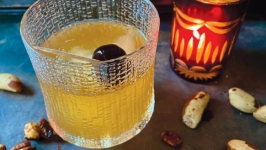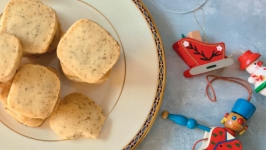Harvest Calendar
Each spring, in preparation for the herring’s return to Southeast Alaska, Heather Douville and her dad Michael harvest a seal. Heather’s Tlingit name is Kootink, her clan is Shank’weidi wolf, and she lives on Prince of Wales Island, part of the ancestral homelands of the Tlingit people. She practices traditional ways of life that trace back over 10,000 years. Traditional foods—those hunted, fished, gathered, and grown from land and sea— are everything to Douville. She honors those who came before, practicing cultural traditions of harvesting and sharing with elders and the people in the community.
“Food is full of stories. It’s the land. It’s culture. It’s honoring elders. It’s where you come from. We take pride in our work of harvesting, processing, and using as much of the animal as possible,” Douville said.
For Douville and her community, traditional foods serve as a lifeline to cultural roots, and as a means to pass knowledge on to future generations. Harvesting and processing are deeply rooted in cultural identity and are vital to honoring and preserving cultural heritage, and land and water stewardship. She and her family live by a harvest calendar, which is a different way of measuring time than the 365 day a year Gregorian calendar.
“It’s not like going to the store and buying whatever food you want. How you eat depends on the seasonal food source. There’s a season for each thing—seal, herring, seaweed, beach asparagus, salmon, deer,” Douville said.
Seal
Douville marks the beginning of the harvest calendar with the taking of a seal in spring in preparation for herring season. She looks for a medium to large animal because its fat has better texture than a smaller seal. Female seals yield more oil, while males have more “crispy fat.” To make seal oil, thin slices of fat with no meat attached are boiled in a large pot until oil foams. Oil is then scooped off the top and stored in jars. The remaining fat is cooked into crispy fat. The oil that remains in the pot is used to fry intestines and meat. Seal oil is a nutritional powerhouse. It can be spooned over a plate of piping hot herring eggs or added to the water when blanching herring eggs. Once a seal is taken, it must be skinned and processed immediately. If not, oil will oxidize on the fur and stain it yellow. After skinning a seal, Douville washes the pelt with soap. She then fleshes the pelt—removing fat and membrane from the underside of the skin—and washes it with soap once more and pickles it in salt. Later, at the end of the harvest calendar, Douville will use the seal for sewing projects.
“There’s a real art to processing a seal and it’s important to be all finished before the arrival of the herring,” Douville said.
Herring
Where Douville lives, the herring generally spawn the first week of April. The sea turns milky with milt. Seal, sea lions, whales, eagles, and king salmon congregate in a feeding frenzy. Beforehand, Douville and her family cut a number of hemlock boughs. When the herring begin to spawn, they set the trees in the ocean using rocks as anchors. Herring spawn on the branches, leaving impressive clumps of tiny eggs. Once Douville and her family have enough roe, they cut free any remaining boughs to give the next generation of herring a better chance of success. The herring roe Douville and her family gather is shared with her community, along with seal oil that the eggs are dipped into.
Seaweed and Beach Asparagus
In late spring, Douville harvests seaweed and beach asparagus. Black seaweed is a valuable delicacy across Southeast Alaska. The Tlingit word for beach asparagus is sukkáadzi. After carefully cutting the stalks, sukkáadzi needs to be rinsed and then it can be eaten fresh, frozen, dried, or canned. Sukkáadzi and seaweed, along with all traditional foods, are shared with elders.
“We practice that with any type of harvest. We always give away more than we keep. We won’t harvest unless we need it. It’s important to minimize waste at all times. Sometimes we won’t harvest seaweed for two years if we already have enough. We also have to make sure we harvest enough so we don’t miss out,” Douville said.
Salmon and Halibut
The first salmon of the year are king salmon, prized throughout Alaska for their beauty and taste. Because king salmon are a bigger, thicker fish, Douville cold smokes strips that will later be steam-cooked or canned. Douville and her dad fish with náxw, hand-carved wooden hooks, for halibut. Later in the summer, Douville makes dry fish out of sockeye, coho, and even pink and chum salmon. Salmon season ends with the harvesting of eggs from late runs of chum and coho salmon to make kashís’i, or “Indian cheese,” a process that involves aging, smoking, and grinding skeins of eggs before pressing them into a cheese-like delicacy.
Deer
Deer hunting season opens in late summer, but Douville waits until she’s finished processing salmon. Her first hunt is in late October or early November. After she takes a deer, Douville guts the animal and then places the emptied stomach and liver back in the cavity. She turns the deer into a backpack and packs the animal out whole. The first meal she eats is deer bone soup, which she consumes while processing the rest of the animal. Douville keeps deer hides for sewing projects.
“One deer is enough for me, but we make sure we get deer for elders. My great grandmother taught us to bury the deer’s pancreas back into the land where Raven can’t get it. She told my dad, ‘If you do this, you’ll always get more deer.’”
Seal and Fur Sewing
In December or January, after deer hunting is finished, Douville and her dad take their second seal of the year. They use oil from the animal to dip dry fish in. By then Douville has gotten the tanned skins of animals taken earlier in the season back from a tannery. Her Aunt Deb taught her the art of skin sewing and it’s something that fosters an even deeper connection to the animal and to her culture.
Soon a new harvest year will start.
“Herring brings all the sea life back. And it all begins again,” Douville said.
Author’s note: Heather Douville’s Instagram account, @akmoosie, is the best wild food social media platform I’ve come across. She shares in detail her harvesting of, processing of, and connection to food.
This originally appeared in Issue 33, Fall 2024















